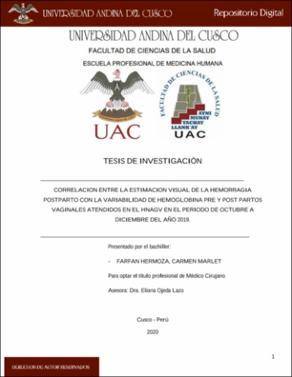| dc.contributor.advisor | Ojeda Lazo, Eliana Janette | |
| dc.contributor.author | Farfan Hermoza, Carmen Marlet | |
| dc.date.accessioned | 2020-09-22T22:26:21Z | |
| dc.date.available | 2020-09-22T22:26:21Z | |
| dc.date.issued | 2020-06-12 | |
| dc.identifier.uri | https://hdl.handle.net/20.500.12557/3432 | |
| dc.description.abstract | Antecedentes: La Hemorragia postparto (HPP) es una de las principales causas de muerte
materna a nivel mundial. Afecta al 2% de parturientas a nivel mundial y el 24% de
muertes maternas ocurridas en Essalud a nivel Nacional corresponden a HPP.
Actualmente no existe ningun metodo que nos ayude a determinar con exactitud la
perdida sanguinea en el postparto, sin embargo hay estudios que demuestran que la
estimación visual es el mas impreciso y el menos confiable. El Objetivo de este estudio es
Determinar la correlación entre la estimación visual de la hemorragia posparto con la
variabilidad de la hemoglobina pre y post parto vaginal en pacientes atendidas en el
Departamento de Gineco Obstetricia del Hospital Nacional Adolfo Guevara Velasco -
ESSALUD Cusco, Perú durante el periodo de octubre a diciembre del año 2019.
Métodos: Se realizó un estudio retrospectivo, transversal, analítico correlacional, en el
Servicio de Gineco obstetricia del HNAGV Essalud, Cusco. Se incluyo pacientes de
partos vaginales unicos, con análisis de hemoglobina antes y después del parto. Análisis
de datos: Coeficiente de Correlación de Spearman, análisis descriptivo con Desviaciòn
estándar, analisis bivariado con intervalo de confianza al 95%, p< 0,05.
Resultados: Existe coeficiente de Spearman de 0,04 entre la pérdida sanguínea estimada
visualmente y la perdida sanguínea real. El nivel de variabilidad de hemoglobina fue de
1,74 g/dl ± 1 g/dl.. La media de la perdida sanguínea por estimación visual fue de 172 ml ± 78,7 ml. La mayoría de las pacientes tenía entre 25 a 35 años, procedían de zonas
urbanas, con una edad gestacional a término al momento del parto. El 64,5% de pacientes
tuvo una hemoglobina preparto dentro de parámetros normales, y el 86,9% de pacientes,
anemia moderada después del parto. El 52% presentó hemorragia postparto no
diagnosticado por estimación visual. Existe una asociación estadísticamente significativa
entre la procedencia de la paciente, retención de restos placentarios, anemia preparto, y
segundo periodo de parto, con la perdida sanguínea real postparto.
Conclusiones: Existe una correlación débil entre la perdida sanguinea estimada
visualmente y la perdida calculada por variabilidad de la hemoglobina, desestimando el
uso de la estimación visual como un método diagnostico de HPP. | es_PE |
| dc.description.abstract | Background: Postpartum hemorrhage (PPH) is one of the leading causes of maternal death
worldwide. It affects 2% of women in labor worldwide and 24% of maternal deaths
occurred in Essalud nationwide correspond to PPH. Currently, there is no method that
helps us to accurately determine blood loss in the postpartum period, however there are
studies that show that visual estimation is the most imprecise and the least reliable. The
objective of this study is to determine the correlation between the visual estimation of
postpartum hemorrhage with the variability of hemoglobin pre and post vaginal delivery
in patients treated at the Department of Gynecology and Obstetrics of the National
Hospital Adolfo Guevara Velasco - ESSALUD Cusco, Peru during the period from
October to December of the year 2019.
Methods: A retrospective, cross-sectional, analytical, correlational study was carried out
at the Obstetric Gynecology Service of the HNAGV Essalud, Cusco. Patients with single
vaginal deliveries were included, with hemoglobin analysis before and after delivery. Data
analysis: Spearman Correlation Coefficient, descriptive analysis with Standard Deviation,
bivariate analysis with 95% confidence interval, p <0.05.
Results: There is a Spearman coefficient of 0.04 between visually estimated blood loss
and actual blood loss. The level of hemoglobin variability was 1.74 g / dl ± 1 g / dl. The mean of the blood loss by visual estimation was 172 ml ± 78.7 ml. Most of the patients
were between 25 and 35 years old, came from urban areas, with a gestational age at term
at the time of delivery. 64.5% of patients had a prepartum hemoglobin within normal
parameters, and 86.9% of patients, moderate anemia after delivery. 52% presented
postpartum hemorrhage undiagnosed by visual estimation. There is a statistically
significant association between the patient's origin, retention of placental remains,
antepartum anemia, and the second period of delivery, with the actual postpartum blood
loss.
Conclusions: There is a weak correlation between visually estimated blood loss and the
loss calculated by hemoglobin variability, dismissing the use of visual estimation as a
diagnostic method of PPH. | en_US |
| dc.description.uri | Tesis | es_PE |
| dc.format | application/pdf | es_PE |
| dc.language.iso | spa | es_PE |
| dc.publisher | Universidad Andina del Cusco | es_PE |
| dc.rights | info:eu-repo/semantics/openAccess | es_PE |
| dc.rights.uri | https://creativecommons.org/licenses/by-nc-nd/2.5/pe/ | es_PE |
| dc.source | Universidad Andina del Cusco | es_PE |
| dc.source | Repositorio Institucional UAC | es_PE |
| dc.subject | Hemorragia posparto | es_PE |
| dc.subject | Edad gestacional | es_PE |
| dc.subject | Pacientes | es_PE |
| dc.title | Correlación entre la estimación visual de la hemorragia postparto con la variabilidad de hemoglobina pre y post partos vaginales atendidos en el HNAGV en el periodo de octubre a diciembre del año 2019 | es_PE |
| dc.type | info:eu-repo/semantics/bachelorThesis | es_PE |
| thesis.degree.name | Médico Cirujano | es_PE |
| thesis.degree.grantor | Universidad Andina del Cusco. Facultad de Ciencias de la Salud | es_PE |
| thesis.degree.level | Titulo Profesional | es_PE |
| thesis.degree.discipline | Medicina Humana | es_PE |


